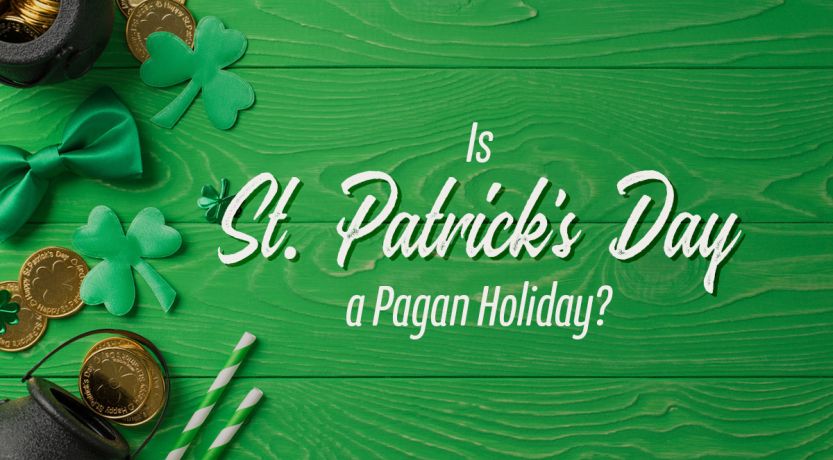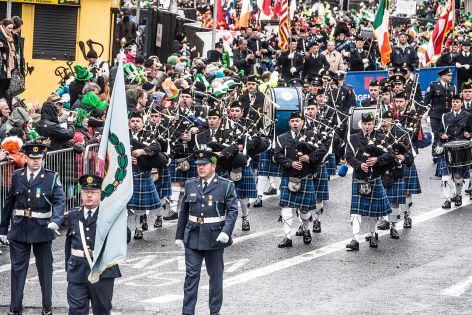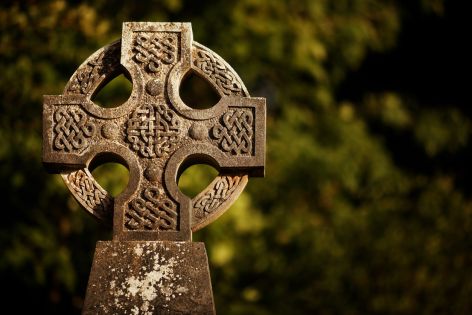Is St. Patrick’s Day a Pagan Holiday?
Millions celebrate St. Patrick’s Day each year, but few consider its true origins. Is it an innocent cultural holiday? Should Christians celebrate St. Patrick’s Day?

On March 17, millions of people will celebrate an Irish holiday called St. Patrick’s Day by viewing parades, dressing in green, decorating with shamrocks and leprechauns, drinking green-colored beer or grabbing a shamrock shake.
St. Patrick’s Day has become very popular in the United States due to its fun atmosphere and the fact that millions of Americans have some Irish ancestry. It is mainly celebrated in countries that have a significant Irish population.
St. Patrick’s Day parade in Ireland. Many believe this holiday is a harmless cultural festival (William Murphy/Wikipedia).
But what are the true origins of this holiday? Is it just a harmless celebration of Irish culture?
What are the origins of St. Patrick’s Day?
The history of St. Patrick’s Day begins with the man himself. Though many of the stories about him are shrouded in legend, there are some generally agreed upon facts.
According to History.com, Patrick was born in Britain, but when he was 16, he was kidnapped from his home by Irish raiders.
After spending six years in captivity in Ireland, he supposedly received a vision from God instructing him to leave Ireland and managed to escape and return to Britain. Upon returning home, he claimed to receive a second vision in which God commissioned him to preach to the people of Ireland, many of whom practiced Celtic paganism.
It seems his actual name was Maewyn Succat, but he changed his name to the Latin Patricius when he became a priest. After being ordained a priest, Patrick was sent back to Ireland with a twofold commission: to serve the existing Christians in Ireland and to convert the native people.
Patrick’s history is rooted in syncretism
Today, Patrick is recognized as the patron saint of Ireland, popularly credited for converting many of the Irish people to Catholic Christianity. However, peeling back the layers of history, we notice something interesting and troubling about how he approached his mission.
In short, Patrick employed the all-too-common method known as syncretism.
The Cambridge Dictionary defines syncretism as “the combining of different religions, cultures, or ideas.” This may sound relatively innocuous, but take a moment to think about it.
Syncretism is the blending of two or more religious beliefs that do not agree with each other to achieve one unified belief system.
Celtic cross. The cross surrounded by a disk is known as an Irish Cross and is still prominently displayed throughout Ireland.
(For a more in-depth study on the meaning of syncretism and its dangers, read “What Is Religious Syncretism? Does God Accept It?”)
Patrick relied heavily on syncretism to further the spread of Christianity in Ireland. In the fifth century, Irish culture was rife with pagan practices and beliefs steeped in mysticism. Patrick likely learned this during his time in captivity.
Instead of introducing purely biblical beliefs, he integrated certain practices and rituals from the native Irish culture into his teachings.
According to some sources, the Irish pagans lit large bonfires to honor their gods. Legends suggest that Patrick adopted their practice and lit bonfires in Ireland to represent Christ as “the light of the world.”
Similarly, because the native spirituality of the Irish was centered on nature, particularly the sun, Patrick supposedly took the sun disk and placed it over the cross. In so doing, he ensured that “veneration of the symbol [of the cross] would seem more natural to the Irish” (“Who Was St. Patrick?”). Today, the symbol of the cross surrounded by a disk is known as an Irish Cross and is still prominently displayed throughout Ireland.
Interestingly, the cross symbol already had pagan connections even before the sun disk was added to it. (To learn more about the cross’s history, read: “Should the Cross Symbolize Your Christianity?” and “Is It Okay to Wear a Cross? Why or Why Not?”)
Though much of his life is shrouded in mystery, if the accepted history of his life is true, it seems Patrick used syncretism to slowly and subtly introduce Catholic beliefs without facing outright rejection from the native people.
But did he genuinely convert them, or did he simply encourage their ongoing practice of pagan worship under the guise of Christianity?
What about traditions like shamrocks and leprechauns?
Patrick paved a path for syncretism that has continued over time. The celebration of St. Patrick’s Day, a day originally intended to commemorate his death, has accumulated a variety of strange and seemingly unrelated traditions over the years.
Most notably, shamrocks and leprechauns have become integral to the day and its celebrations. But what connection do these symbols have with Christianity?
According to some legends, Patrick used the three-leafed shamrock, a type of clover abundant in Ireland, to teach the native Irish about the Trinity. Consequently, the shamrock has become a prominent symbol of his holiday.
The truth is that the shamrock associated with Patrick is not a harmless cultural image, but a symbol of a false religious teaching about God’s nature. (To learn why the Trinity is a deeply flawed explanation of God’s nature, read “The Trinity: What Is It?” and “The Trinity: Could the Mysterious Tradition Be Unbiblical?”)
The leprechaun comes from pagan Irish mythology. Leprechauns are pictured as mischievous spirits who loved pranks and gold. (To learn about the dangers of these kinds of things, download our free booklet The Spirit World: Facts and Fallacies.)
What about luck and St. Patrick’s Day?
Another tradition associated with St. Patrick’s Day is luck.
During this holiday, the phrase the luck of the Irish is commonly heard, and various items symbolizing luck are associated with the holiday. These include shamrocks, four-leaf clovers, horseshoes and pots of gold.
Good luck charms? The notion of luck associated with this holiday is derived from various pagan traditions and superstitions.
The concept of luck, the idea that a random and unpredictable force impacts and shapes life events, is not just foreign to the Bible—it is totally contrary to it. Christians should avoid all such superstitions and myths.
Instead of depending on luck and good fortune,
Christians rely on God for protection and blessings while also recognizing that Satan, other people or sometimes simply time and chance can cause bad things to occur.
To learn about the biblical perspective on luck and superstitions, read “What Does the Bible Say About Superstitions?”
What is the problem with patron saints?
Another issue with St. Patrick’s Day is its connection to the Roman Catholic tradition of declaring patron saints. In Catholicism, a saint is a person whom the church declares to be in heaven and who can be prayed to as an intercessor between people and God.
Though Patrick never went through the modern canonization process, he became a Catholic saint by tradition and is recognized as the patron saint of Ireland. That means he is considered the special intercessor between the Irish and God. Because of this, Irish Catholics will often pray to Patrick for protection or blessings.
Millions of non-Catholics who would otherwise never celebrate a Catholic patron saint feast day celebrate Patrick’s feast day.
(To learn why this is unbiblical, read “Should We Pray to Saints?”)
The Catholic Church has declared certain days as celebrations of specific patron saints. Patrick’s feast day is March 17, the traditional day of his death. Millions of non-Catholics who would otherwise never celebrate a Catholic patron saint feast day celebrate Patrick’s feast day.
Perhaps you fall into this category. It may be unintentional—you may have thought you were just participating in a harmless celebration of Irish culture. Hopefully, learning these facts will motivate you to reassess your perspective on this holiday.
Christians should understand that the entire idea of patron saints and saint feast days is highly problematic and blatantly unbiblical. The Bible defines a saint as anyone with God’s Holy Spirit and teaches that no man, including God’s faithful saints, has gone to heaven (John 3:13).
To learn the biblical definition of a saint, read “How to Become a Saint.”
What does the Bible say about St. Patrick’s Day?
How should Christians approach holidays connected to paganism, such as St. Patrick’s Day?
Exodus 20:3 shows God’s clear commandment for people to have no other gods before Him. But God’s instruction on the subject didn’t end there.
God wanted anything connected to paganism to be destroyed so that the Israelites wouldn’t be tempted to use it.
In Deuteronomy 12:29-30, God instructed the Israelites as they were about to enter the Promised Land and encounter the nations who lived there, “Take heed to yourself that you are not ensnared to follow them . . . and that you do not inquire after their gods, saying, ‘How did these nations serve their gods? I also will do likewise.’”
God is so opposed to pagan worship that He commanded the children of Israel to destroy the vestiges of paganism left behind by the peoples they replaced in the land. “Destroy their altars, break their sacred pillars, and cut down their wooden images” (Exodus 34:13).
God wanted anything connected to paganism to be destroyed so that the Israelites wouldn’t be tempted to use it.
The message to avoid paganism is also found in the New Testament.
In Galatians 4:8-9, Paul urged members to avoid the pagan practices they once followed: “But then, indeed, when you did not know God, you served those which by nature are not gods. But now after you have known God . . . how is it that you turn again to the weak and beggarly elements, to which you desire again to be in bondage?”
How do we avoid false worship?
How do we avoid compromising with paganism? By worshipping God the way He wants—free of any symbols, images or practices from ancient pagan worship.
Thankfully, God doesn’t leave us without instructions on worshipping Him properly. Scripture instructs us on what to do and what not to do in our worship of God.
From the 10 Commandments in Exodus 20 to the descriptions of God’s annual festivals in Leviticus 23, the Bible provides clear and direct insight into God’s desired form of worship. It’s the only form of worship that is—or ever will be—acceptable to Him.
To learn more about God’s days of worship, read “Biblical Festivals.”
Avoid compromising with paganism
Patrick has been revered for centuries for bringing Catholicism to the people of Ireland. But a closer examination of these popular legends shows he didn’t lead them out of Celtic paganism into biblical Christianity. Instead, the traditions around St. Patrick’s Day show a blending of paganism into a religion that already had a long history of religious syncretism.
As March 17 approaches, take a moment to consider the origins of St. Patrick’s Day and the spirit of mistaken compromise lurking deep within its history.
St. Patrick’s Day is not a harmless cultural festival.
Originally posted on Mar. 17, 2024. Updated on Feb. 18, 2025.
Date Posted: March 17, 2025




